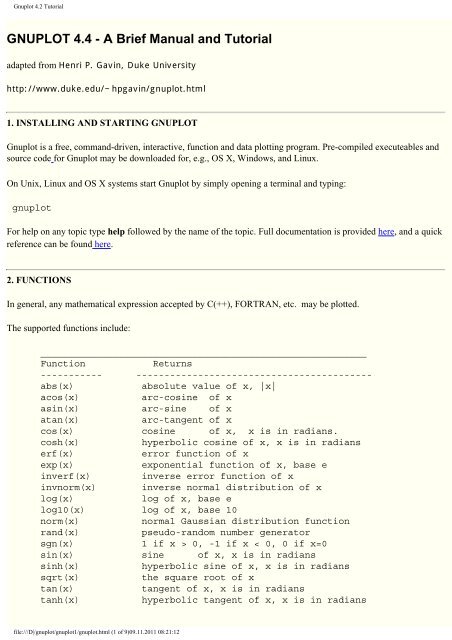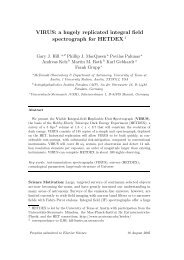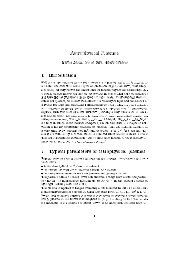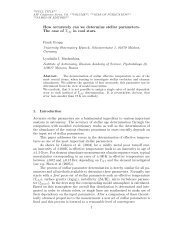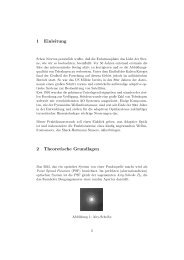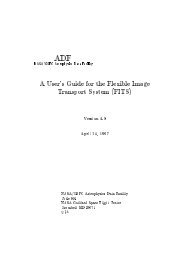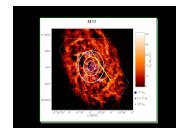Create successful ePaper yourself
Turn your PDF publications into a flip-book with our unique Google optimized e-Paper software.
<strong>Gnuplot</strong> <strong>4.2</strong> <strong>Tutorial</strong>GNUPLOT 4.4 - A Brief Manual and <strong>Tutorial</strong>adapted from Henri P. Gavin, Duke Universityhttp://www.duke.edu/~hpgavin/gnuplot.html1. INSTALLING AND STARTING GNUPLOT<strong>Gnuplot</strong> is a free, command-driven, interactive, function and data plotting program. Pre-compiled executeables andsource code for <strong>Gnuplot</strong> may be downloaded for, e.g., OS X, Windows, and Linux.On Unix, Linux and OS X systems start <strong>Gnuplot</strong> by simply opening a terminal and typing:gnuplotFor help on any topic type help followed by the name of the topic. Full documentation is provided here, and a quickreference can be found here.2. FUNCTIONSIn general, any mathematical expression accepted by C(++), FORTRAN, etc. may be plotted.The supported functions include:__________________________________________________________FunctionReturns----------- ------------------------------------------abs(x)absolute value of x, |x|acos(x)arc-cosine of xasin(x) arc-sine of xatan(x)arc-tangent of xcos(x) cosine of x, x is in radians.cosh(x)hyperbolic cosine of x, x is in radianserf(x)error function of xexp(x)exponential function of x, base einverf(x)inverse error function of xinvnorm(x) inverse normal distribution of xlog(x)log of x, base elog10(x) log of x, base 10norm(x)normal Gaussian distribution functionrand(x)pseudo-random number generatorsgn(x) 1 if x > 0, -1 if x < 0, 0 if x=0sin(x) sine of x, x is in radianssinh(x)hyperbolic sine of x, x is in radianssqrt(x)the square root of xtan(x)tangent of x, x is in radianstanh(x)hyperbolic tangent of x, x is in radiansfile:///D|/gnuplot/gnuplot1/gnuplot.html (1 of 9)09.11.2011 08:21:12
<strong>Gnuplot</strong> <strong>4.2</strong> <strong>Tutorial</strong>___________________________________________________________Bessel, gamma, ibeta, igamma, and lgamma functions are alsosupported. Many functions can take complex arguments.Binary and unary operators are also supported.The supported operators in <strong>Gnuplot</strong> are the same as the corresponding operators in the C programminglanguage, except that most operators accept integer, real, and complex arguments. The ** operator (exponentiation)is supported as in FORTRAN. Parentheses may be used to change the order of evaluation. The variable names x, y,and z are used as the default independent variables.3. THE plot AND splot COMMANDSplot and splot are the primary commands in <strong>Gnuplot</strong>. They plot functions and data in many many ways. plot isused to plot 2-d functions and data, while splot plots 3-d surfaces and data.Syntax:plot {[ranges]}{[function] | {"[datafile]" {datafile-modifiers}}}{axes [axes] } { [title-spec] } {with [style] }{, {definitions,} [function] ...}where either a [function] or the name of a data file enclosed in quotes is supplied. For more complete descriptions,type: help plot, help plot using or help plot smooth .3.1 Plotting FunctionsTo plot functions simply type: plot [function] at the gnuplot> prompt.For example, try:gnuplot> plot sin(x)/xgnuplot> splot sin(x*y/20)gnuplot> plot sin(x) title 'Sine Function', tan(x) title 'Tangent'Simple surface plot, using splotgnuplot> splot [x=-1:1] [y=-1:1] sqrt(x**2+y**2)gnuplot> set isosamples 20, 20 #increase default resolutiongnuplot> replotgnuplot> set contour#with contour levelsgnuplot> set cntrparam level 10 #10 levelsgnuplot> replotfile:///D|/gnuplot/gnuplot1/gnuplot.html (2 of 9)09.11.2011 08:21:12
<strong>Gnuplot</strong> <strong>4.2</strong> <strong>Tutorial</strong>Simple parametric 3-D plot (2-D plots analogue)gnuplot> set paramgnuplot> set isosamples 40, 40 #increase default resolutiongnuplot> splot sin(u)*sin(v),sin(u)*cos(v),cos(u) #spheregnuplot> splot [u=0:pi/2] [v=0:2*pi]sin(u)*sin(v),sin(u)*cos(v),cos(u)#half-spheregnuplot> set contour #with contour levelsgnuplot> set cntrparam level 10gnuplot> replotgnuplot> set hidden3d #hidden line removalgnuplot> replotfile:///D|/gnuplot/gnuplot1/gnuplot.html (3 of 9)09.11.2011 08:21:12
<strong>Gnuplot</strong> <strong>4.2</strong> <strong>Tutorial</strong>For more information on plotting 3-D surfaces, type3.2 Plotting Datagnuplot> help splotDiscrete data contained in a file can be displayed by specifying the name of the data file (enclosed in quotes) on theplot or splot command line. Data files should have the data arranged in columns of numbers. Columns should beseparated by white space (tabs or spaces) only, (no commas). Lines beginning with a # character are treated ascomments and are ignored by <strong>Gnuplot</strong>. A blank line in the data file results in a break in the line connecting datapoints.For example your data file, force.dat , might look like:# This file is called force.dat# Force-Deflection data for a beam and a bar# Deflection Col-Force Beam-Force0.000 0 00.001 104 510.002 202 1010.003 298 1480.0031 290 1490.004 289 2010.0041 291 2090.005 310 2500.010 311 2600.020 280 240file:///D|/gnuplot/gnuplot1/gnuplot.html (4 of 9)09.11.2011 08:21:12
<strong>Gnuplot</strong> <strong>4.2</strong> <strong>Tutorial</strong>You can display your data by typing:gnuplot> plot "force.dat" using 1:2 title 'Column', \"force.dat" using 1:3 title 'Beam'Do not type blank space after the line continuation character, "\" .Your data may be in multiple data files.In this case you may makeyour plot by using a command like:gnuplot> plot "fileA.dat" using 1:2 title 'data A', \"fileB.dat" using 1:3 title 'data B'For information on plotting 3-D data, type:gnuplot> help splot datafile4. CUSTOMIZING YOUR PLOTMany items may be customized on the plot, such as the ranges of the axes, the labels of the x and y axes, the styleof data point, the style of the lines connecting the data points, and the title of the entire plot.4.1 plot command customizationCustomization of the data columns, line titles, and line/point style are specified when the plot command is issued.Customization of the data columns and line titles were discussed in section 3.Plots may be displayed in one of eight styles: lines, points, linespoints, impulses, dots, steps, fsteps, histeps,errorbars, xerrorbars, yerrorbars, xyerrorbars, boxes, boxerrorbars, boxxyerrorbars, financebars, candlesticks orvector To specify the line/point style use the plot command as follows:gnuplot> plot "force.dat" using 1:2 title 'Column' with lines, \"force.dat" u 1:3 t 'Beam' w linespointsNote that the words: using , title , and with can be abbreviated as: u , t , and w . Also, each line and point style hasan associated number.<strong>4.2</strong> set command customizationCustomization of the axis ranges, axis labels, and plot title, as well as many other features, are specified using theset command. Specific examples of the set command follow. (The numerical values used in these examples arearbitrary.) To view your changes type: replot at the gnuplot> prompt at any time.Create a title:> set title "Force-Deflection Data"Put a label on the x-axis: > set xlabel "Deflection (meters)"Put a label on the y-axis: > set ylabel "Force (kN)"Change the x-axis range: > set xrange [0.001:0.005]Change the y-axis range: > set yrange [20:500]file:///D|/gnuplot/gnuplot1/gnuplot.html (5 of 9)09.11.2011 08:21:12
<strong>Gnuplot</strong> <strong>4.2</strong> <strong>Tutorial</strong>260Have <strong>Gnuplot</strong> determine ranges: > set autoscaleMove the key: > set key at 0.01,100Delete the key:> unset keyPut a label on the plot: > set label "yield point" at 0.003,Remove all labels:> unset labelPlot using log-axes:> set logscalePlot using log-axes on y-axis: > unset logscale; set logscale yChange the tic-marks: > set xtics (0.002,0.004,0.006,0.008)Return to the default tics: > unset xtics; set xtics autoOther features which may be customized using the set command are: arrow, border, clip, contour, grid, mapping,polar, surface, time, view, and many more. The best way to learn is by reading the on-line help information, tryingthe command, and reading the <strong>Gnuplot</strong> manual.5. PLOTTING DATA FILES WITH OTHER COMMENT CHARACTERSIf your data file has a comment character other than # you can tell <strong>Gnuplot</strong> about it. For example, if your data filehas "%" comment characters (for Matlab compatability), typinggnuplot> set datafile commentschars "#%"indicates that either a "#" or a "%" character starts a comment.6. GNUPLOT SCRIPTSSometimes, several commands are typed to create a particular plot, and it is easy to make a typographical errorwhen entering a command. To stream- line your plotting operations, several <strong>Gnuplot</strong> commands may be combinedinto a single script file. For example, the following file will create a customized display of the force-deflection data:# <strong>Gnuplot</strong> script file for plotting data in file "force.dat"# This file is called force.pset autoscale # scale axes automaticallyunset log# remove any log-scalingunset label# remove any previous labelsset xtic auto# set xtics automaticallyset ytic auto# set ytics automaticallyset title "Force Deflection Data for a Beam and a Column"set xlabel "Deflection (meters)"set ylabel "Force (kN)"set key at 0.01,100set label "Yield Point" at 0.003,260set arrow from 0.0028,250 to 0.003,280set xr [0.0:0.022]set yr [0:325]plot "force.dat" using 1:2 title 'Column' with linespoints , \"force.dat" using 1:3 title 'Beam' with pointsfile:///D|/gnuplot/gnuplot1/gnuplot.html (6 of 9)09.11.2011 08:21:12
<strong>Gnuplot</strong> <strong>4.2</strong> <strong>Tutorial</strong>Then the total plot can be generated with the command: gnuplot> load 'force.p'Note: symbols and linestyles can vary from terminal to terminal. To display the actual styles, typegnuplot> test7. CURVE-FITTING WITH GNUPLOTTo fit the data in force.dat with a function use the commands:f1(x) = a1*tanh(x/b1)# define the function to be fita1 = 300; b1 = 0.005;# initial guess for a1 and b1fit f1(x) 'force.dat' using 1:2 via a1, b1Final set of parametersAsymptotic Standard Error======================= ==========================a1 = 308.687 +/- 10.62 (3.442%)b1 = 0.00226668 +/- 0.0002619 (11.55%)and the commands:f2(x) = a2 * tanh(x/b2)# define the function to be fita2 = 300; b2 = 0.005;# initial guess for a and bfit f2(x) 'force.dat' using 1:3 via a2, b2Final set of parametersAsymptotic Standard Error======================= ==========================a2 = 259.891 +/- 12.82 (4.933%)b2 = 0.00415497 +/- 0.0004297 (10.34%)file:///D|/gnuplot/gnuplot1/gnuplot.html (7 of 9)09.11.2011 08:21:12
<strong>Gnuplot</strong> <strong>4.2</strong> <strong>Tutorial</strong>The curve-fit and data may now be plotted with the commands:set key at 0.018,150 title "F(x) = A tanh (x/B)"# title to key!set title "Force Deflection Data \n and curve fit" # note newline!set pointsize 1.5# larger point!set xlabel 'Deflection, {/Symbol D}_x (m)'# Greek symbols!set ylabel 'Force, {/Times-Italic F}_A, (kN)'# italics!plot "force.dat" using 1:2 title 'Column data' with points pt 3, \"force.dat" using 1:3 title 'Beam data' with points pt 4, \a1 * tanh( x / b1 ) title 'Column-fit: A=309, B=0.00227', \a2 * tanh( x / b2 ) title 'Beam-fit: A=260, B=0.00415'Note: Greek symbols, italics etc. will be displayed only for an 'enhanced' text mode, subject to the available fonts.gnuplot> set term x11 enhanced8. SPREAD-SHEET LIKE CALCULATIONS ON DATA<strong>Gnuplot</strong> can mathematically modify your data column by column:to plot sin( col.3 + col.1 ) vs. 3 * col.2 type:plot 'force.dat' using (3*$2):(sin($3+$1))file:///D|/gnuplot/gnuplot1/gnuplot.html (8 of 9)09.11.2011 08:21:12
<strong>Gnuplot</strong> <strong>4.2</strong> <strong>Tutorial</strong>9. MULTI-PLOT<strong>Gnuplot</strong> can plot more than one figure in a frame ( like subplot in matlab ) i.e., try:set multiplot;set size 1,0.5;set origin 0.0,0.5;set origin 0.0,0.0;unset multiplotplot sin(x);plot cos(x)# get into multiplot mode# exit multiplot mode10. GNUPLOT DEMO FILES AND THE GNUPLOT FAQMost of <strong>Gnuplot</strong>'s current features are illustrated in one or more of the <strong>Gnuplot</strong> demonstration files. To run thedemo's yourself, copy the corresponding directory to your home directory, start <strong>Gnuplot</strong> from within, and typeload "all.dem"The <strong>Gnuplot</strong> feature you are looking for will probably be illustrated in one of the demo files.11. HARD-COPY (PLOTTING ON PAPER)You can create a PostScript file of your plot by using the commands.set terminal postscript landscape color enhancedset output "my-plot.ps"# or any other filenamereplotunset outputset terminal x11 enhanced12. FURTHER READING / MORE TUTORIALSGrundkurs <strong>Gnuplot</strong> (in German): http://userpage.fu-berlin.de/~voelker/gnuplotkurs/gnuplotkurs.htmlVisualisierung mit gnuplot - eine Einführung (in German): http://www.tu-chemnitz.de/urz/kurse/unterlagen/gnuplot/gnuplot.html<strong>Gnuplot</strong> -- not so Frequently Asked Questions: http://t16web.lanl.gov/Kawano/gnuplot/index-e.htmlfile:///D|/gnuplot/gnuplot1/gnuplot.html (9 of 9)09.11.2011 08:21:12


